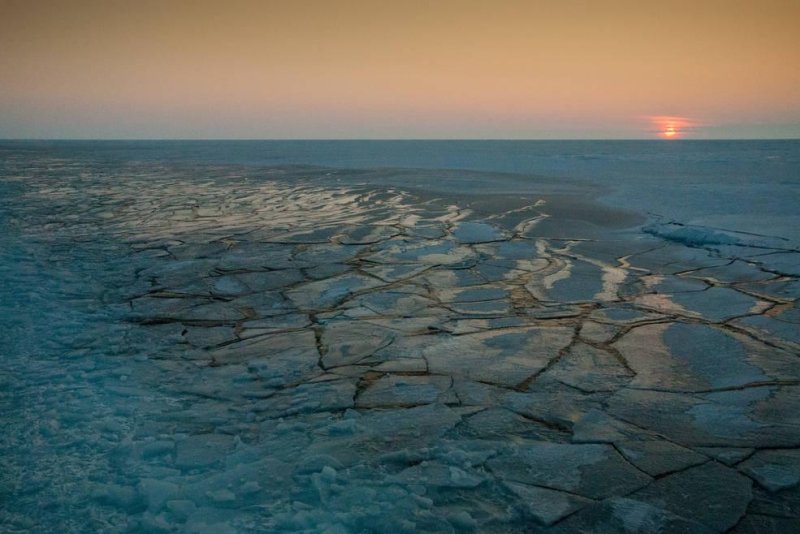Sea ice in the Arctic is still on the decline, but new research suggests it is regrowing at faster rates during the winter than it was a few decades ago. Photo by NASA/Alek Petty
Dec. 6 (UPI) -- Sea ice coverage in the Arctic has been on a precipitous decline over the last few decades, but new research from NASA suggests an increase in wintertime ice growth could help slow the trend -- but only momentarily.
Despite the study's surprising revelation, scientists say the longterm prognosis for the ice caps remains poor.
"This increase in the amount of sea ice growing in winter doesn't overcome the large increase in melting we've observed in recent decades," Alek Petty, a sea ice scientist at NASA's Goddard Space Flight Center, said in a news release. "Overall, thickness is decreasing. Arctic sea ice is still very much in decline across all seasons and is projected to continue its decline over the coming decades."
Petty is the lead author of the new study of wintertime ice growth in the Arctic. The research was recently accepted for publication in the journal Geophysical Research Letters.
Maximum and minimum extents have been historically small in recent years. No region has been more affected by climate change than the Arctic, where increasing temperatures, combined with influxes of warm ocean water -- as well as some natural climate variability -- have caused dramatic ice losses.
Despite those loses, new modeling efforts suggest some parts of the Arctic are experiencing increasing rates of wintertime ice growth. Scientists use a combination of climate models and measurements captured by the European Space Agency's CryoSat-2 satellite, to estimate ice thickness variability across the Arctic over the last several decades.
The modeling efforts showed Arctic sea ice was on average 6.6 feet thick in October during the 1980s. Over the winter, Arctic sea ice in the 80s added on average an extra 3.3 feet of ice. As both models and satellite measurements revealed, parts of the Arctic have been growing wintertime ice at an accelerated rate.
Simulations suggest wintertime sea ice may continue to grow at accelerated rates for several more decades. In the coming years, Arctic ice may add as much as fix extra feet of ice over the winter.
"Our findings highlight some resilience of the Arctic sea ice cover," Petty said. "If we didn't have this negative feedback, the ice would be declining even faster than it currently is. Unfortunately, the positive feedback loop of summer ice melt and increased solar absorption associated with summer ice melting still appears to be dominant and continue to drive overall sea ice declines."
The increase in wintertime ice growth could alter the ocean mixing patterns. When ice forms, fresh water freezes and saltier water is discharged into the ocean. Because salt water is denser and sinks, increases in surface salinity can encourage ocean mixing.
"This is altering the seasonal balance and the salinity distribution of the upper ocean in the Arctic; it's changing when we have fresh water, when we have salty water and how deep and seasonal that upper oceanic mixed layer is," Petty said. "And that's all going to mean that local micro-organisms and ecosystems have to adapt to these rapidly evolving conditions."
Petty and his colleagues think the effects of global warming will eventually reverse the feedback loop fueling accelerating wintertime sea ice growth. In other words, the trend detailed in the new study won't be enough to prevent the Arctic from becoming ice-free by the end of the century.















